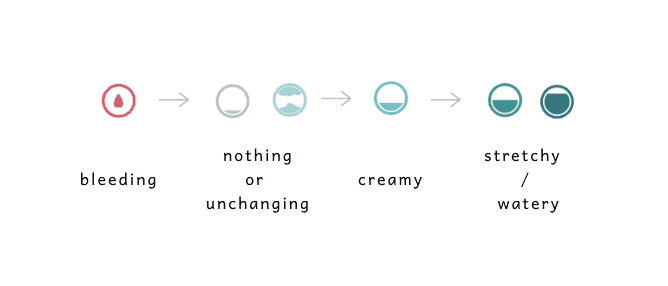05 Charting & Observing Cervical Fluid
All Language Edition
Observing & Charting Cervical Fluid
Typically, throughout a woman’s cycle a progression will occur with her cervical fluid:

And a sensation will progress from:

After menstruation, a dense plug will form in the cervix which is impenetrable to sperm. This pattern is either dry, with no cervical fluid present or a pattern of unchanging discharge may be seen. This is caused by small fragments of the bottom of the plug from breaking off. Both indicate infertility.
As the ovaries stimulate estrogen, the cervix produces cervical fluid that frees the plug. Sticky, tacky or creamy cervical fluid may be seen and felt. Sperm can now enter the cervix — this is the point of change and indicates possible fertility.
As the ovaries produce increasing amounts of estrogen, cervical fluid gets progressively wetter with a lubricated or slippery sensation — this is the most fertile cervical fluid.
During the days after the slippery sensation (following ovulation) the infertile plug will form again: the cervix will close and sperm will not be able to enter. A dry sensation will be felt or an unchanging pattern of discharge will return signalling infertility for the remainder of the cycle.
Some things to note:
– Women will almost always experience a slight moistness at the vulva.
– You’re considered ‘dry’ if there’s no cervical fluid present.
– Some women’s cervical fluid won’t change day to day.
– We each have our own cervical fluid patterns and sensation that
are unique to us individually.
How To Observe Cervical Fluid
There are two options for how do this:
Option 1: Checking the vulva
Start observing your cervical fluid at least three times throughout the day.
Before going to the toilet, wash your hands, wipe the tip of a clean finger or a piece of toilet paper just inside your vulva to check your cervical fluid.
Feel the sample between your fingers to gauge the texture. If there’s nothing there, you would be dry. If you do notice cervical fluid, notice if the consistency is sticky, creamy or stretchy and if it the color is white or clear.
> As we each have our own cervical fluid patterns that are unique to us, use your own words to describe what is seen and felt.
At the end of the day, record on your chart the wettest cervical fluid you experienced throughout the day. (So if you experienced creamy, stretchy, then creamy; you would record the most fertile reading as stretchy for the day).
Option 2: What is felt and what is seen (no internal observation)
Start observing your cervical fluid at least three times throughout the day.
Just as you can feel the sensation of menstruation, and see blood during your period, you can feel the sensation of being dry or the sensation of being lubricated.
Throughout the day, sense if you feel dry or wet. Then before going to the bathroom, notice in your underwear what you see; notice if the consistency is sticky or watery, and white / cream or clear.
> As we each have our own cervical fluid patterns that are unique to us, use your own words to describe what is felt and what is seen.
At the end of the day, record on your chart the wettest you felt or saw throughout the day. (So if you experienced slippery, watery, then slippery; you would record the most fertile reading as watery for the day).
☆
Dry / Unchanging Pattern = infertile
As soon as you feel a shift to:
—> Moist, slippery or wet sensation
—> Creamy, stretchy, watery appearance
= Your fertile window has opened
To Note:
– Our vaginas inherently have a ‘moistness’.
If you’re getting confused, or you’re finding it difficult to categorize your cervical fluid each day; try the ‘what is felt and what is seen’ way without internally checking for the following cycle.
– Choose the observation method that you prefer.
– Stick with the same way of observing throughout a cycle for consistency.
Fertile cervical fluid can keep sperm alive for five days; potentially leading to a pregnancy if you ovulate within that time frame! Charting with the fertility awareness method will be equipt you with the knowledge of which days could lead to pregnancy and which days not; empowering your choices!
>> Action Step: Start observing and tracking your cervical fluid daily on your chart.


